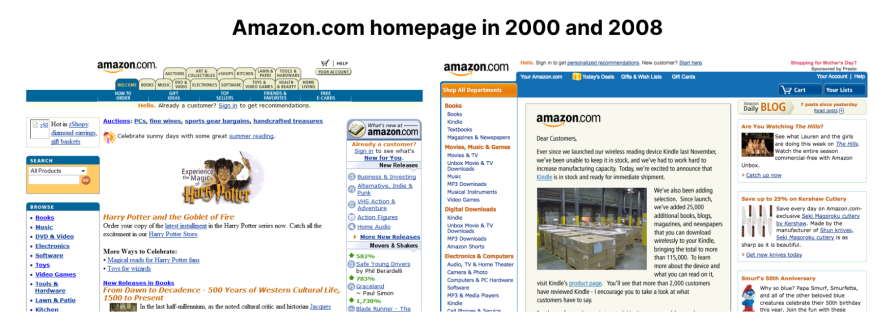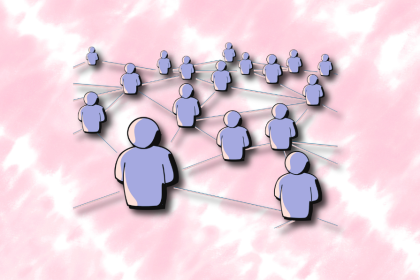Design is becoming faster and cheaper thanks to templates, no-code tools, and AI. But at a steep cost. As businesses prioritize efficiency, design is being treated as a commodity — quick, standardized, and replicable. Like a drive-thru order. This shift strips design of its strategic value, turning it from a problem-solving discipline into a task-based service that’s easy to overlook.

We live in an age of instant everything. Messages are sent in seconds. Groceries arrive within hours. A ride appears with a tap. These services add value by saving time. The design industry is no exception. In fast-paced, growth-driven companies, time to market is everything. Netflix, for example, outpaced Blockbuster with its monthly subscription model, ditching late fees and capturing market share. Moving faster — or adopting tools like generative AI earlier — can mean beating the competition.
With the rise of $29 templates, no-code tools, and generative AI, it’s easier and cheaper than ever to get design work done. A small business can launch a site in hours. Tools like Uizard and Visily generate mockups in minutes. With the right prompt, anyone can produce high-fidelity screens. Sure, a designer still needs to refine the output — but these tools speed up workflows and help explore ideas faster.
But this demand for speed is turning design into a commodity, something that can be ordered off a menu and mass-produced, rather than a strategic craft based on business goals and user needs. It’s like comparing a generic, off-the-rack suit to a bespoke one that’s tailored to your specific requirements.
When design is treated this way, we lose what makes it valuable. At its core, design is about solving problems, aligning with business goals, and creating meaningful experiences. When design becomes a generic order off a menu, we miss the purpose of design entirely.
Hustle culture is still going strong, especially among young adults. With living costs rising, many turn to freelancing or side gigs to stay afloat. I’ve been there. The constant stress of chasing the next paycheck eventually pushed me toward a more stable 9-to-5.
Lately, though, I’ve noticed a shift. Some freelance designers are adopting subscription models — flat monthly rates instead of negotiating each project. It’s a page straight out of the SaaS playbook.
While this adds financial stability, it also reinforces the idea that design is a packaged, repeatable service. And that, I think, chips away at its perceived value.
In the early days of the web, UX design emerged as a response to confusing, clunky interfaces. It was seen as a strategic tool — a way to humanize design by focusing on the user’s experience rather than just eye-catching visuals.
An example is Amazon’s redesign of its website in the early 2000s. The company prioritized usability by refining tabbed navigation, improving page discoverability, and optimizing for responsiveness. These UX improvements were based on years of understanding their users’ behavior and pain points. By strategically applying usability best practices, Amazon reduced friction, built trust, and ultimately drove long-term business growth:

Over time, however, many companies shifted focus toward performance metrics and measurable outcomes. While chasing growth at all costs, many have prioritized what works over originality. When one business finds success with a particular landing page layout or UI design, others quickly follow suit, replicating the exact structure in hopes of achieving similar results.
The mindset became — ”Don’t fix what isn’t broken.”
This rinse-and-repeat approach has led to a flood of lookalike websites and products. Scroll through startup websites and you’ll see the same minimalist hero sections, three-column benefit rows, and predictable CTAs.
While this templated design approach may save time and generate quick wins, it drains the uniqueness from digital experiences. Brands lose identity. And that emotional connection with users grows weak.
For example, Flora and SingleStore feature nearly identical landing pages above-the-fold, consisting of center-aligned content, a news link placed just above the headline (set in a semi-bold sans-serif font), followed by prominent “free trial” and “contact us” CTAs, and a row of customer logos to complete it off. These are just two examples of companies that use a very similar template, which may suit their needs, but it’s a pattern repeated so often that none of these pages stand out:

Design is increasingly packaged into productized services, like website templates, landing pages, and generic UX audits offered at a fixed price. Instead of being a strategic differentiator, design becomes a checklist item.
Templates aren’t inherently bad — some businesses don’t need fully custom solutions. But when design lacks intention, empathy, and a deep understanding of user pain points and business goals, companies start to look and feel identical, and struggle to truly connect with anyone.
In recent years, side hustles and entrepreneurship have gained popularity, partly driven by challenging economic times and a desire for greater control over income. It’s difficult for business owners to get ahead when income is often uncertain. With layoffs and restrictive job markets, even full-time employees have started building up side hustles as a backup plan.
In the pursuit of income stability and recurring revenue, many freelance designers and design agencies alike have turned to offering subscription-based service models, similar to SaaS (software-as-a-service) companies.

Instead of dealing with the tedious and sometimes frustrating process of scoping projects, negotiating terms, and chasing down payments, designers have adopted a productized subscription service model that provides some level of certainty in their runway. Clients pay a flat monthly fee and, in return, can submit unlimited requests, which are completed one at a time. This model is convenient for businesses that need design support but can’t justify hiring a full-time designer.
However, the agency or freelancer providing these services often needs to take on multiple clients simultaneously in order to turn a profit. This puts pressure on them to complete projects quickly, which prioritizes production speed over quality. As a result, strategic thinking and discovery are often pushed aside in favor of fast execution.
Foundational UX activities, such as conducting user research, gathering context, and understanding users’ needs, are ignored. While clients may think they are saving time and money by getting screens delivered faster, they often don’t realize the hidden costs, such as a poor onboarding flow, increased support tickets due to frustrating experiences, and design patterns that don’t scale.
By relying on generic, productized services, clients risk wasting time and resources later on by redesigning and fixing work that could have been done correctly from the start.
As Charlie Kaplan, VP of Product at Audiomack, said in a Leader Spotlight interview:
I would always take hard empiricism over speed, because I’ve been in situations where I was running very fast, but in the wrong direction.
While this model can provide designers with financial stability, it reinforces the perception that design is purely an executional process. It’s seen as a task-based service rather than a strategic function. Clients can order any design they think they need, much like a fast food menu, and have it delivered, as long as they continue to pay the subscription fee. However, they often miss the deeper impact that thoughtful, strategic design can deliver.
Gone are the days of value-based pricing, where the cost of design work reflected the impact it could make on a client’s business. Productized design works against designers who are constantly advocating for users and striving to prove their strategic worth within teams and organizations. With an emphasis on templates, quick turnarounds, and deliverables over discovery, commoditized design floods the internet with the same-looking brands and uninspired user experiences.
As everything starts to look the same, businesses believe they know exactly what they want. The landing page that works for one business will most likely work for others. The mobile application that feels familiar has a better chance of user adoption, so it’s safer to copy what’s already working. Businesses can shop around until they find a designer willing to replicate it for the lowest price.
Freelance marketplaces like Fiverr and Upwork make this even easier, promoting low-cost gigs that start as low as $5. Designers often struggle to charge fair rates when others are willing to offer the same services for a fraction of the price, whether due to lower living costs or simply trying to build a portfolio.
This creates a frustrating environment for experienced designers, who frequently lose out on projects to cheaper, less strategic competitors. At the same time, junior designers living in high-cost areas have to compete with seasoned freelancers charging far less. This mentality fuels a race to the bottom, where designers and agencies undercut each other to win projects that require little originality and even less strategy.
As commoditized design continues to boom in popularity, the perceived value of design is shrinking, as its actual value is being overlooked. When design is treated as an afterthought or an add-on, its ability to drive innovation, solve complex problems, and differentiate a brand gets lost in the noise. As a result, the impact is evident in key metrics, including higher bounce rates, lower user retention rates, increased support ticket volume, and stagnant Net Promoter Score (NPS) scores.
To counteract this trend, designers should reposition their work to focus on outcomes rather than outputs. Instead of selling screens or components, frame your value in terms of the problems you solve, like boosting a business’s online revenue, increasing its conversion rate, or improving user task success. It’s up to designers to lead this conversation and help prospects see design as a supporting business function rather than an expense.
When you understand your client’s real goals, you may realize that their initial design request isn’t actually what they need. Use that moment to educate them on how design can drive meaningful results, not just serve aesthetic purposes.
To restore the true value of design, we must challenge the notion that design is simple, generic, and one-size-fits-all. Good design isn’t just about visual aesthetics or using a trendy template. It’s about deeply understanding your users’ goals, pain points, and behaviors, and creating solutions that are specific to those needs.
Many businesses think design is something that can be easily replicated. If a certain landing page worked for one company, then it should work for them too. But what happens when they don’t get the results that they’re expecting?
Strategic design is rooted in a mix of design thinking, business strategy, and systems thinking. It goes beyond surface-level aesthetics to align design decisions with broader organizational goals. Activities like user research, stakeholder interviews, Jobs To Be Done, and journey mapping are just a few examples of actual UX practices that contribute to successfully applying design as a strategic function. When done thoughtfully, design can shape the entire customer experience and set the foundation for your business’s long-term success.
The next time you kick off a new project, start by uncovering the root of the problem or goal. What is your client truly trying to achieve? Ask questions like, “What problem are we solving? Who are we solving it for? What outcome would you like to achieve as a result? How does this experience move the needle for the business and the user?”
From there, you will have a better idea of how to apply design thinking to address their real needs. Don’t just take design requests at face value. These kinds of insights require time, collaboration, and context, which can’t be found in a pre-built UI kit or generic template.
So to restore its value, designers must position themselves not just as creators of assets, but as partners in solving meaningful problems. And businesses must move away from the idea that design is interchangeable. Because a generic design may look good, but a good design works.
The commoditization of design has created a dangerous illusion that good design is quick, cheap, and easily replicated. When businesses treat design as a product, they sacrifice the strategy and empathy that make it effective. Design without any design thinking leads to generic interfaces, copycat brands, and missed opportunities to connect meaningfully with users.
Going forward, designers, teams, and clients must work together to reclaim design as a strategic tool for business. That means prioritizing research, aligning with business goals, understanding real user needs, and resisting the urge to default to what’s fast or familiar. Cutting corners might get you immediate results, but long-term, you won’t stand out in the sea of sameness.
So designers, before taking on your next project, ask these three questions:
Asking these questions upfront will shift the conversation from delivering outputs to creating outcomes. That’s how we can stop commoditizing design one step at a time and start making it matter again.
LogRocket's Galileo AI watches sessions and understands user feedback for you, automating the most time-intensive parts of your job and giving you more time to focus on great design.
See how design choices, interactions, and issues affect your users — get a demo of LogRocket today.

Discover how to craft UX-friendly hero sections with examples, design tips, and strategies that drive engagement and conversion.

I once sent a half-written email by accident, until Gmail saved me with an Undo button. Those tiny moments define trust in UX. In this guide, we’ll break down how to design reversible actions, when to use them, and how to choose the right recovery pattern for your product.

Small qualitative samples aren’t a weakness. They’re a strategy. This guide breaks down the evidence, the mindset gap, and how to build trust around research decisions.

From pixel art to neon palettes, retro design is resurging across marketing, gaming, fashion, and indie web. Learn how nostalgia, brand differentiation, and anti-minimalism fatigue are shaping modern UX and how to balance style with usability.